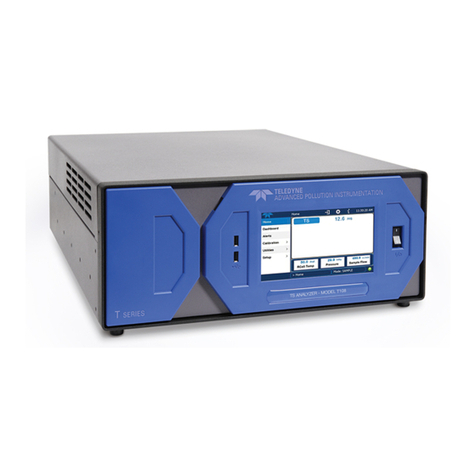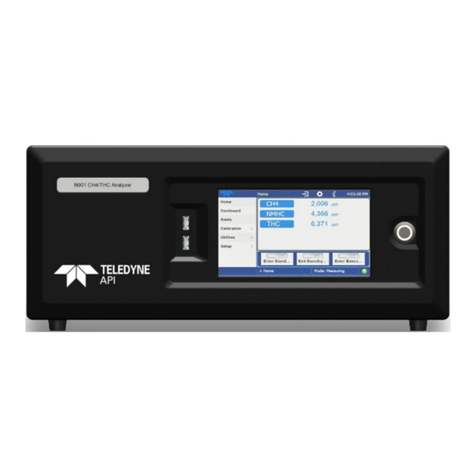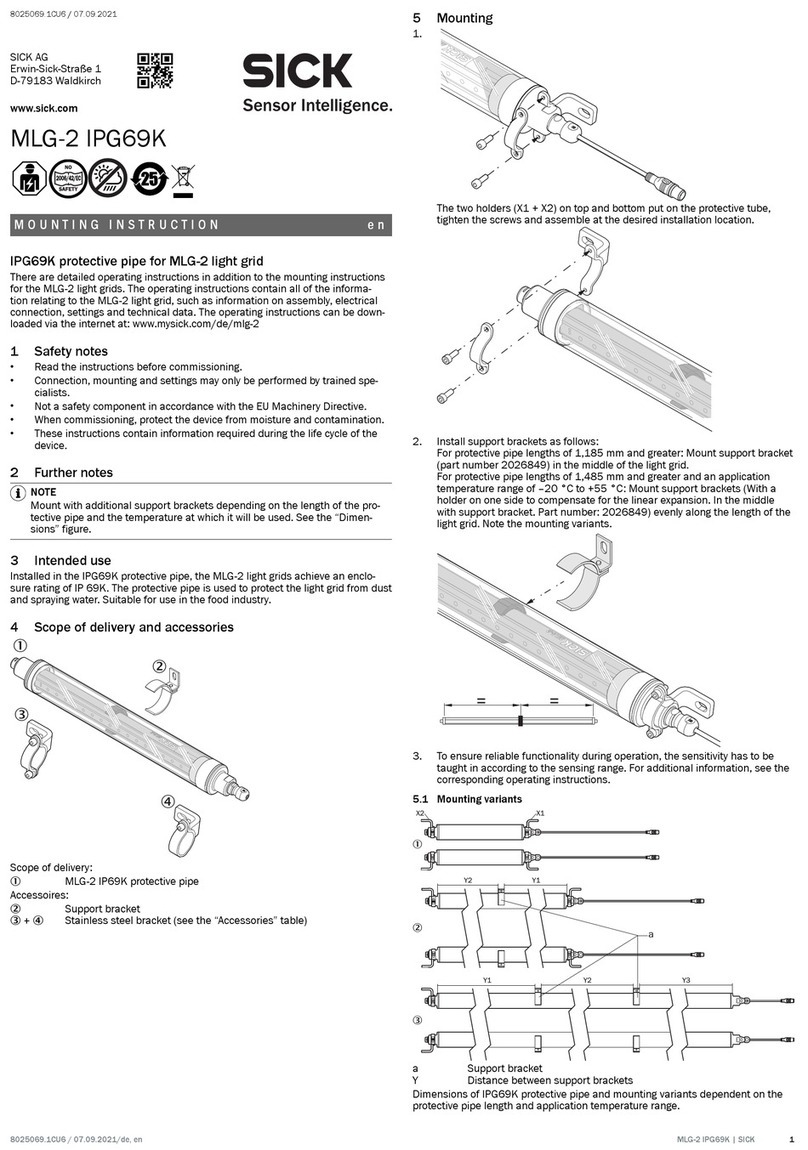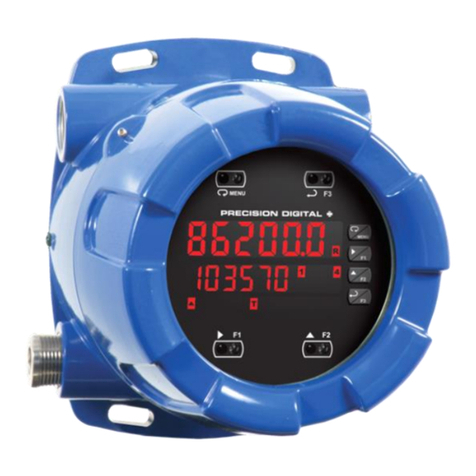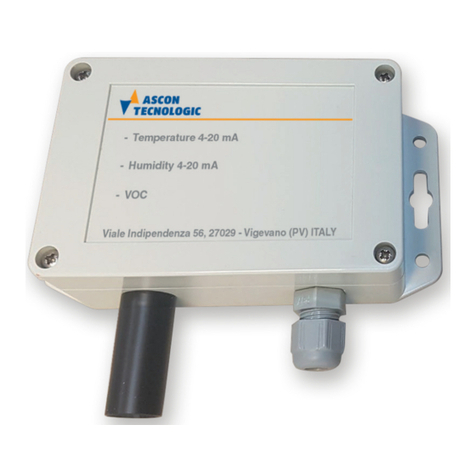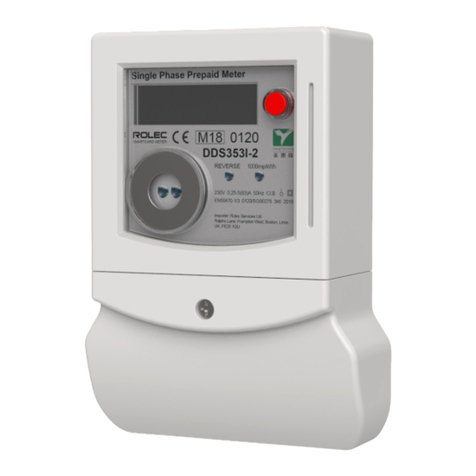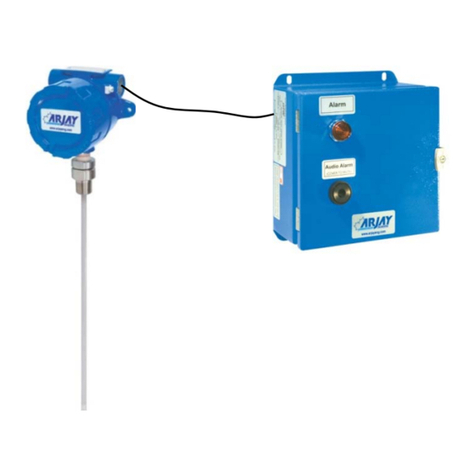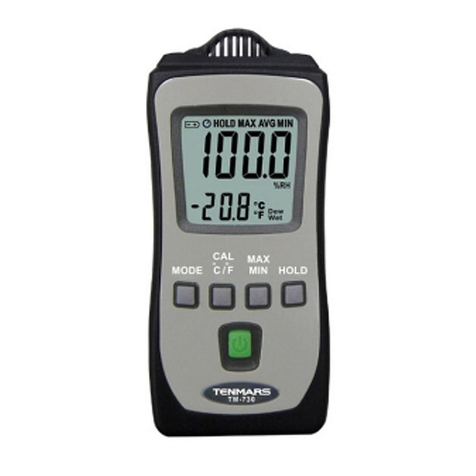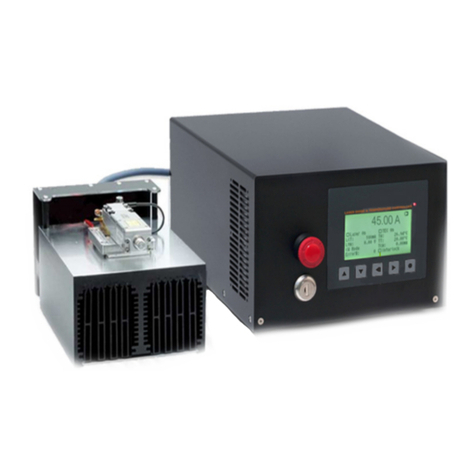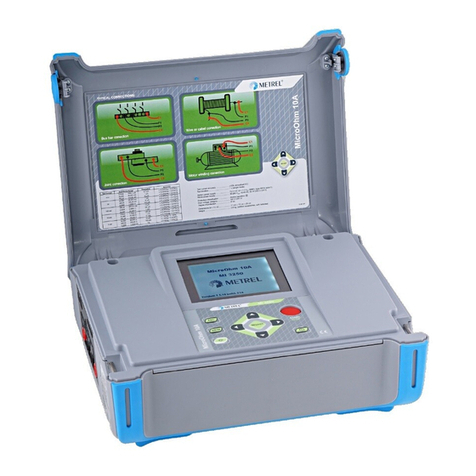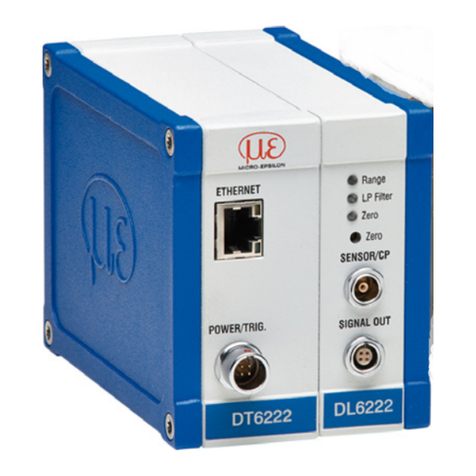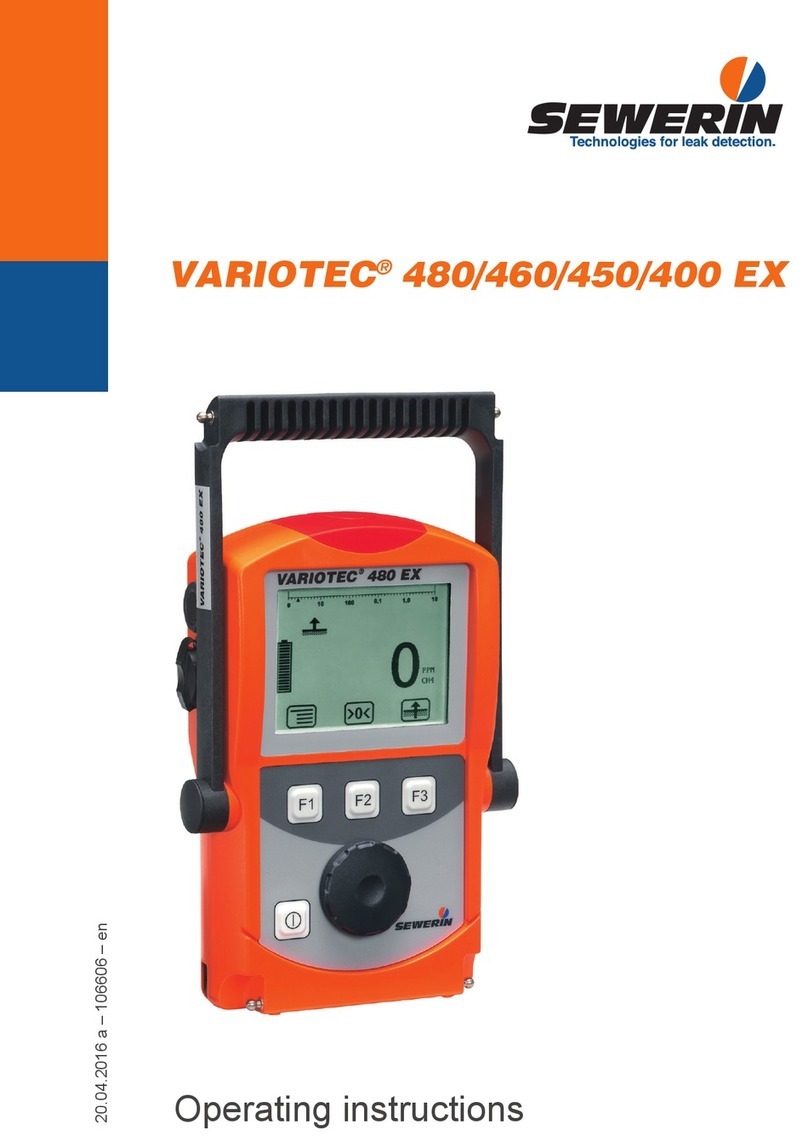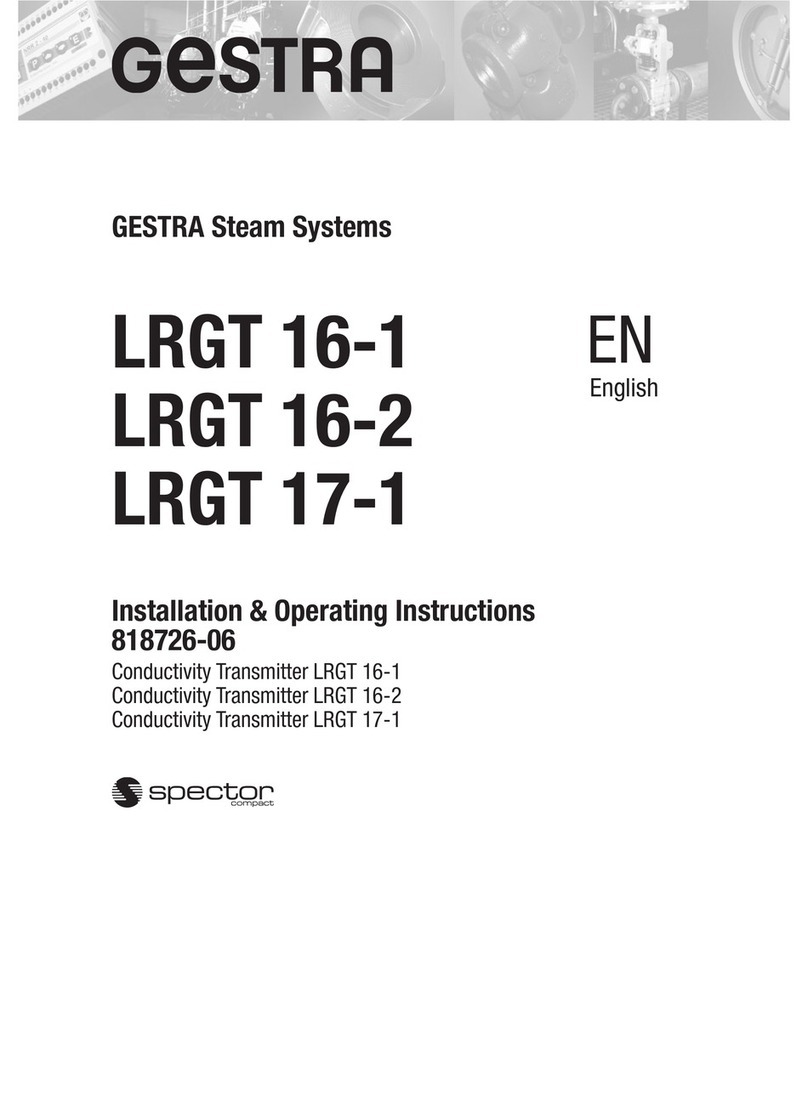TELEDYNE API N300 User manual

Part Number 092010300A DCN8475 20 May 2022
User Manual
Models N300, N300M
CO Analyzers
© Teledyne API (TAPI)
Toll-free Phone:
+1 800-324-5190
9970 Carroll Canyon Road
Phone:
+1 858-657-9800
San Diego, California
Fax:
+1 858-657-9816
92131-1106
Email:
api-sales@teledyne.com
USA
Website:
http://www.teledyne-api.com


092910300A DCN8475 Teledyne API – Models N300/N300M CO Analyzers i
NOTICE OF COPYRIGHT
© 2022 Teledyne API (TAPI). All rights reserved.
TRADEMARKS
All trademarks, registered trademarks, brand names or product names appearing in this
document are the property of their respective owners and are used herein for
identification purposes only.

ii Teledyne API – Models N300/N300M CO Analyzers 092910300A DCN8475
SAFETY MESSAGES
Important safety messages are provided throughout this manual for the purpose of
avoiding personal injury or instrument damage. Please read these messages carefully.
Each safety message is associated with a safety alert symbol and is placed throughout this
manual; the safety symbols are also located inside the instrument. It is imperative that
you pay close attention to these messages, the descriptions of which are as follows:
WARNING: Electrical Shock Hazard
HAZARD: Strong oxidizer
GENERAL WARNING/CAUTION: Read the accompanying message
for specific information.
CAUTION: Hot Surface Warning
Do Not Touch: Touching some parts of the instrument without
protection or proper tools could result in damage to the part(s) and/or
the instrument.
Technician Symbol: All operations marked with this symbol are to be
performed by qualified maintenance personnel only.
Electrical Ground: This symbol inside the instrument marks the
central safety grounding point for the instrument.
CAUTION
This instrument should only be used for the purpose and in the
manner described in this manual. If you use this instrument in a
manner other than that for which it was intended, unpredictable
behavior could ensue with possible hazardous consequences.
NEVER use any combustible/explosive gas with this product!
For Technical Assistance regarding the use and maintenance of this instrument or any
other Teledyne API product, contact Teledyne API’s Technical Support Department:
Telephone: +1 800-324-5190 (toll free) or +1 858-657-9800
Email: api-techsupport@teledyne.com
or access any of the service options on our website at http://www.teledyne-api.com/

092910300A DCN8475Teledyne API – Models N300/N300M CO Analyzers iii
CONSIGNES DE SÉCURITÉ
Des consignes de sécurité importantes sont fournies tout au long du présent manuel dans
le but d’éviter des blessures corporelles ou d’endommager les instruments. Veuillez lire
attentivement ces consignes. Chaque consigne de sécurité est représentée par un
pictogramme d’alerte de sécurité; ces pictogrammes se retrouvent dans ce manuel et à
l’intérieur des instruments. Les symboles correspondent aux consignes suivantes :
AVERTISSEMENT : Risque de choc électrique
DANGER : Oxydant puissant
AVERTISSEMENT GÉNÉRAL / MISE EN GARDE
: Lire la consigne
complémentaire pour des renseignements spécifiques
MISE EN GARDE : Surface chaude
Ne pas toucher : Toucher à certaines parties de l’instrument sans protection ou
sans les outils appropriés pourrait entraîner des dommages aux pièces ou à
l’instrument.
Pictogramme « technicien » : Toutes les opérations portant ce symbole doivent
être effectuées uniquement par du personnel de maintenance qualifié.
Mise à la terre : Ce symbole à l’intérieur de l’instrument détermine le point central
de la mise à la terre sécuritaire de l’instrument.
MISE EN GARDE
Cet instrument doit être utilisé aux fins décrites et de la manière décrite dans
ce manuel. Si vous utilisez cet instrument d’une autre manière que celle pour
laquelle il a été prévu, l’instrument pourrait se comporter de façon imprévisible
et entraîner des conséquences dangereuses.
NE JAMAIS utiliser de gaz explosive ou combustible avec cet produit!

iv Teledyne API – Models N300/N300M CO Analyzers 092910300A DCN8475
WARRANTY
WARRANTY POLICY (02024J)
Teledyne API (TAPI), a business unit of Teledyne Instruments, Inc., provides that:
Prior to shipment, TAPI equipment is thoroughly inspected and tested. Should equipment
failure occur, TAPI assures its customers that prompt service and support will be
available. (For the instrument-specific warranty period, please refer to the “Limited
Warranty” Section in the Terms and Conditions of Sale on our website at:
http://www.teledyne-api.com.
COVERAGE
After the warranty period and throughout the equipment lifetime, TAPI stands ready to
provide on-site or in-plant service at reasonable rates similar to those of other
manufacturers in the industry. All maintenance and the first level of field troubleshooting
are to be performed by the customer.
NON-TAPI MANUFACTURED EQUIPMENT
Equipment provided but not manufactured by TAPI is warranted and will be repaired to
the extent and according to the current terms and conditions of the respective equipment
manufacturer’s warranty.
PRODUCT RETURN
All units or components returned to Teledyne API should be properly packed for
handling and returned freight prepaid to the nearest designated Service Center. After the
repair, the equipment will be returned, freight prepaid.
Please review the complete Terms and Conditions of Sale on our website.
CAUTION – Avoid Warranty Invalidation
Failure to c
omply with proper anti-Electro-Static Discharge (ESD) handling
and pa
cking instructions and Return Merchandise Authorization (RMA)
procedures when returning parts for r
epair or calibration may void your
warranty. For anti
-ESD handling and packing instructions please refer to
the manual, Fundamentals of ESD, PN 04786, in its
“Packing
Components for Return to Teledyne API’s Customer Service”
section. The
manual can be down
loaded from our website at http://www.teledyne-
api.com
. RMA procedures can also be found on our website.

092910300A DCN8475Teledyne API – Models N300/N300M CO Analyzers v
ABOUT THIS MANUAL
NOTE We recommend that all users read this manual in its
entirety before operating the instrument.
CONVENTIONS USED
In addition to the safety symbols as presented in the Safety Messages page, this manual
provides special notices related to the careful and effective use of the instrument and
related, pertinent information.
ATTENTION
COULD DAMAGE INSTRUMENT AND VOID
WARRANTY
This special notice provides information to avoid
damage to your instrument and possibly invalidate
the warranty.
IMPORTANT IMPACT ON READINGS OR DATA
Provides information about that which could either
affect accuracy of instrument readings or cause loss
of data.
NOTE
Provides information pertinent to the proper care,
operation or maintenance of the instrument or its
parts.

vi Teledyne API – Models N300/N300M CO Analyzers 092910300A DCN8475
TABLE OF CONTENTS
1. Introduction, Specifications, Approvals, & Compliance.................................................................13
1.1 Specifications...............................................................................................................................................14
1.2 EPA Designation .........................................................................................................................................16
1.3 Approvals and Certifications........................................................................................................................16
2. Getting Started............................................................................................................................17
2.1 Unpacking....................................................................................................................................................17
2.1.1 Ventilation Clearance .......................................................................................................................18
2.2 Instrument Layout ........................................................................................................................................19
2.2.1 Front Panel.......................................................................................................................................19
2.2.2 Rear panel........................................................................................................................................20
2.2.3 Internal Chassis ...............................................................................................................................21
2.3 Connections and Startup .............................................................................................................................24
2.3.1 Electrical Connections......................................................................................................................24
2.3.1.1 Connecting Power .............................................................................................................24
2.3.1.2 Connecting Analog Outputs Option...................................................................................25
2.3.1.3 Connecting the Digital I/O Expansion Board Option .........................................................26
2.3.1.4 Connecting the Communication Interfaces .......................................................................27
2.3.2 Pneumatic Connections ...................................................................................................................28
2.3.2.1 Critical Tubing, Pressure, Venting and Exhaust Requirements ........................................30
2.3.2.2 Pneumatic Connections: Basic Configuration ...................................................................31
2.3.2.3 Pneumatic Connections: Ambient Zero/Ambient Span Option .........................................32
2.3.2.4 Pneumatic Connections: Ambient Zero/Pressurized Span Option ...................................34
2.3.2.5 Pneumatic Connections: Zero Scrubber/Pressurized Span Option ..................................36
2.3.2.6 Pneumatic Connections: Zero Scrubber/Ambient Span Option (N300) ............................37
2.3.3 Pneumatic Flow Diagrams ...............................................................................................................39
2.3.3.1 Pneumatic Flow: Basic Configuration................................................................................39
2.3.3.2 Pneumatic Flow: N300 Ambient Zero/Ambient Span Valve Option ..................................40
2.3.3.3 Pneumatic Flow: N300 Ambient Zero/Pressurized Span Option ......................................41
2.3.4 Startup, Functional Checks, and Initial Calibration ..........................................................................41
2.3.4.1 Power Status .....................................................................................................................42
2.3.4.2 Startup ...............................................................................................................................42
2.3.4.3 Alerts: Warnings and Other Messages..............................................................................43
2.3.4.4 Functional Checks .............................................................................................................44
2.3.4.5 Initial Calibration ................................................................................................................44
2.4 Menu Overview............................................................................................................................................45
2.4.1 Home Page ......................................................................................................................................46
2.4.2 Dashboard........................................................................................................................................47
2.4.3 Alerts ................................................................................................................................................49
2.4.4 Calibration ........................................................................................................................................50
2.4.5 Utilities..............................................................................................................................................51
2.4.6 Setup ................................................................................................................................................51
2.5 Setup Menu: Features/Functions Configuration.........................................................................................52
2.5.1 Setup>Data Logging (Data Acquisition System, DAS) ....................................................................52
2.5.1.1 Configuring Trigger Types: Periodic..................................................................................55
2.5.1.2 Configuring Trigger Types: Conditional............................................................................55
2.5.1.3 Downloading DAS (Data Acquisition System) Data ..........................................................56
2.5.2 Setup>Events...................................................................................................................................56
2.5.2.1 Editing or Deleting Events .................................................................................................58
2.5.2.2 Using Events as Triggers for Data Logging.......................................................................58
2.5.3 Setup>Dashboard ............................................................................................................................59
2.5.4 Setup>AutoCal (with Valve Option) .................................................................................................59
2.5.5 Setup>Vars ......................................................................................................................................59
2.5.6 Setup>Homescreen .........................................................................................................................61

092910300A DCN8475Teledyne API – Models N300/N300M CO Analyzers vii
2.5.7 Setup>Digital Outputs (Option) ........................................................................................................62
2.5.8 Setup>Analog Outputs (Option).......................................................................................................62
2.5.8.1 Manual Calibration Adjustment of Voltage Range Analog Outputs ..................................66
2.5.8.2 Manual Calibration Adjustment of Current Range Analog Outputs...................................66
2.5.9 Setup>Instrument.............................................................................................................................67
2.5.10 Setup>Comm (Communications).....................................................................................................68
2.5.10.1 COM ..................................................................................................................................68
2.5.10.2 TCP Port1..........................................................................................................................69
2.5.10.3 Network Settings ...............................................................................................................69
2.6 Transferring Configuration to Other Instruments.........................................................................................70
3. Communications and Remote Operation .....................................................................................71
3.1 Serial Communication .................................................................................................................................71
3.2 Ethernet .......................................................................................................................................................71
3.3 NumaView™ Remote ..................................................................................................................................71
4. Calibration ..................................................................................................................................72
4.1 Important Precalibration Information ...........................................................................................................72
4.1.1 Calibration Requirements.................................................................................................................72
4.1.2 Zero Air.............................................................................................................................................73
4.1.3 Calibration (Span) Gas.....................................................................................................................73
4.1.4 Interferents .......................................................................................................................................73
4.1.5 Dilution Ratio Option Software Set Up .............................................................................................73
4.1.6 Second Gas Sensor Options Calibration .........................................................................................74
4.1.7 Data Recording Devices ..................................................................................................................74
4.2 Calibration Procedures ................................................................................................................................74
4.2.1 Calibration and Check Procedures for Basic Configuration.............................................................75
4.2.1.1 Zero Calibration Check and Actual Calibration .................................................................75
4.2.1.2 Span Calibration Check and Actual Calibration ................................................................76
4.2.2 Calibration and Check Procedures with Valve Option Installed.......................................................77
4.2.2.1 Use of Zero/Span Valve with Remote Contact Closure ...................................................78
4.2.2.2 Automatic Cal/Cal Check (AutoCal) with Zero/Span Valve...............................................78
4.3 Calibration Quality .......................................................................................................................................81
4.4 Calibration of the Analyzer’s Electronic Subsystems ..................................................................................81
4.4.1 Dark Calibration Test .......................................................................................................................81
4.4.2 Pressure Calibration.........................................................................................................................81
4.4.3 Flow Calibration ...............................................................................................................................82
4.5 Calibration of Optional Sensors...................................................................................................................82
4.5.1 O2Sensor Calibration ......................................................................................................................82
4.5.2 CO2Sensor Calibration Procedure ..................................................................................................83
4.6 EPA Protocol Calibration .............................................................................................................................84
5. Maintenance and Service ............................................................................................................85
5.1 Maintenance Schedule ................................................................................................................................85
5.2 Predictive Diagnostics .................................................................................................................................88
5.3 Operational Health Checks..........................................................................................................................89
5.4 Software/Firmware Updates ........................................................................................................................90
5.4.1 Remote Updates ..............................................................................................................................90
5.4.2 Manual Reload/Update Procedures .................................................................................................90
5.5 Time Zone Changes ....................................................................................................................................92
5.6 Maintenance Procedures.............................................................................................................................93
5.6.1 Replacing the 47 mm Sample Particulate Filter Option ...................................................................93
5.6.2 Replacing the DFU Filter Option ......................................................................................................94
5.6.3 Rebuilding the Sample Pump ..........................................................................................................94
5.6.4 Performing Leak Checks..................................................................................................................94
5.6.4.1 Vacuum Leak Check and Pump Check.............................................................................94
5.6.4.2 Pressure Leak Check ........................................................................................................95
5.6.5 Performing a Sample Flow Check ...................................................................................................95

viii Teledyne API – Models N300/N300M CO Analyzers 092910300A DCN8475
5.6.6 Cleaning the Optical Bench..............................................................................................................96
5.7 Troubleshooting...........................................................................................................................................96
5.7.1 Fault Diagnosis with Alerts...............................................................................................................97
5.7.2 Fault Diagnosis with Dashboard Functions......................................................................................98
5.7.3 Using The Diagnostic Signal I/O Functions .....................................................................................99
5.7.4Fault Diagnosis with LEDs .............................................................................................................100
5.7.5 Flow Problems ...............................................................................................................................101
5.7.5.1 Flow is Zero .....................................................................................................................102
5.7.5.2 Low Flow .........................................................................................................................103
5.7.5.3 High Flow.........................................................................................................................103
5.7.5.4Flow Alert.........................................................................................................................104
5.7.5.5 Actual Flow Does Not Match Displayed Flow .................................................................104
5.7.5.6 Sample Pump ..................................................................................................................104
5.7.6 Calibration Problems......................................................................................................................105
5.7.6.1 Miscalibrated ...................................................................................................................105
5.7.6.2 Non-Repeatable Zero and Span .....................................................................................105
5.7.6.3 Inability to Span – No SPAN Button ................................................................................106
5.7.6.4 Inability to Zero – No ZERO Button.................................................................................106
5.7.7 Other Performance Problems ........................................................................................................106
5.7.7.1 Temperature Problems....................................................................................................106
5.7.7.2 Excessive Noise ..............................................................................................................107
5.7.7.3 Slow Response................................................................................................................107
5.7.8 Subsystem Check for Troubleshooting ..........................................................................................108
5.7.8.1 AC Main Power................................................................................................................108
5.7.8.2 Touchscreen Interface.....................................................................................................108
5.7.9 RS-232 Communications ...............................................................................................................108
5.8 Service Procedures ...................................................................................................................................109
5.8.1 Replacing the Fuse ........................................................................................................................109
5.8.2 Replacing a Module .......................................................................................................................110
5.8.2.1 Connectors on Mainboard..............................................................................................................111
5.8.2.2 Connectors on DC Pump PCA.......................................................................................................111
5.8.2.3 Connectors on GFC Sensor PCA ..................................................................................................112
5.8.3 Removing/Replacing the GFC Wheel ............................................................................................112
5.9 Frequently Asked Questions .....................................................................................................................115
5.10 Technical Assistance .....................................................................................................................117
6. Theory of Operation ..................................................................................................................118
6.1 Measurement Method................................................................................................................................118
6.1.1 Beer’s Law......................................................................................................................................119
6.2 Measurement Fundamentals.....................................................................................................................119
6.2.1 Gas Filter Correlation .....................................................................................................................120
6.2.1.1 The GFC Wheel...............................................................................................................120
6.2.1.2 The Measure/Reference (M/R) Ratio ..............................................................................121
6.2.1.3 Interference and Signal to Noise Rejection.....................................................................122
6.2.1.4 Summary Interference Rejection .....................................................................................123
6.3 Oxygen Sensor (Option)............................................................................................................................123
6.3.1 Paramagnetic Measurement of O2.................................................................................................123
6.3.1.1 O2Sensor Operation within the Analyzer........................................................................124
6.4 Pneumatic Operation.................................................................................................................................124
6.4.1 Flow Rate Control ..........................................................................................................................125
6.4.1.1 Critical Flow Orifice..........................................................................................................125
6.4.2 Particulate Filter .............................................................................................................................126
6.4.3 Pneumatic Sensors ........................................................................................................................126
6.4.3.1 Sample Pressure Sensor.................................................................................................126
6.4.3.2 Sample Flow Sensor .......................................................................................................126
6.5 Electronic Operation ..................................................................................................................................127
6.5.1 Modules..........................................................................................................................................127

092910300A DCN8475Teledyne API – Models N300/N300M CO Analyzers ix
6.5.2 Power Switches..............................................................................................................................127
6.5.3 Optical Bench & GFC Wheel..........................................................................................................127
6.5.3.1 Temperature Control .......................................................................................................128
6.5.3.2 IR Source.........................................................................................................................128
6.5.3.3 GFC Wheel......................................................................................................................129
6.5.3.4 IR Photo-Detector............................................................................................................130
6.6 Software Operation....................................................................................................................................130
6.6.1 Adaptive Filter for Stability .............................................................................................................131
6.6.2 Calibration - Slope and Offset ........................................................................................................131
6.6.3 Measurement Algorithm .................................................................................................................131
6.6.4 Temperature and Pressure Compensation (TPC) .........................................................................131
Appendix A – MODBUS Registers
Appendix B – Interconnect Diagrams

x Teledyne API – Models N300/N300M CO Analyzers 092910300A DCN8475
FIGURES
Figure 2-1. Front Panel Layout.................................................................................................................................19
Figure 2-2. Rear Panel Layout .................................................................................................................................20
Figure 2-3. Internal Layout – N300...........................................................................................................................21
Figure 2-4. Internal Layout – N300M........................................................................................................................22
Figure 2-5. Optical Bench Layout (shorter bench, N300M, shown) .........................................................................23
Figure 2-6. Analog Outputs Connectors Panel Option .............................................................................................25
Figure 2-7. Digital I/O Connector Panel Option........................................................................................................26
Figure 2-8. Mainboard JP1 Location and Pin Arrangements ...................................................................................27
Figure 2-9. Pneumatic Connections – Basic Configuration Using Bottled Span Gas ..............................................31
Figure 2-10. Pneumatic Connections – Basic Configuration Using Gas Dilution Calibrator ....................................31
Figure 2-11. Pneumatic Connections – Zero/Span Option ......................................................................................33
Figure 2-12. Pneumatic Connections – Ambient Zero/Pressurized Span Option ....................................................34
Figure 2-13. Pneumatic Connections – Zero Scrubber/Pressurized Span Option...................................................36
Figure 2-14. N300 Pneumatic Connections – Zero/Span Option .............................................................................37
Figure 2-15. N300/N300M Internal Gas Flow (Basic Configuration)........................................................................39
Figure 2-16. N300 Internal Pneumatic Flow for Zero/Span Valves Option ..............................................................40
Figure 2-17. N300 Internal Pneumatic Flow for Ambient Zero/Pressurized Span Option........................................41
Figure 2-18. Status Screens at Startup ....................................................................................................................42
Figure 2-19. Home Page Example ...........................................................................................................................43
Figure 2-20. Viewing Active Alerts Page ..................................................................................................................43
Figure 2-21. Sample Dashboard Page .....................................................................................................................44
Figure 2-22. User Interface Orientation ....................................................................................................................46
Figure 2-23. Concentration and Stability Graph (top) and Meter Graph (bottom)....................................................47
Figure 2-24. Dashboard Page ..................................................................................................................................48
Figure 2-25. Navigating to the Active Alerts Page....................................................................................................49
Figure 2-26. Active Alerts Cleared............................................................................................................................50
Figure 2-27. Utilities>Alerts Log of Active and Past Alerts and Events....................................................................50
Figure 2-28. Datalog Configuration, New Log Page.................................................................................................53
Figure 2-29. Datalog Configuration, Existing Log.....................................................................................................53
Figure 2-30. Creating a New Data Log.....................................................................................................................54
Figure 2-31. Datalog Periodic Trigger Configuration................................................................................................55
Figure 2-32. Datalog - Conditional Trigger Configuration ........................................................................................55
Figure 2-33. DAS Download Page ...........................................................................................................................56
Figure 2-34. Events List............................................................................................................................................56
Figure 2-35. Event Configuration..............................................................................................................................57
Figure 2-36. Configured Event Sample ....................................................................................................................57
Figure 2-37. Edit or Delete an Event ........................................................................................................................58
Figure 2-38. Dashboard Display and Configuration .................................................................................................59
Figure 2-39. Homescreen Configuration ..................................................................................................................61
Figure 2-40. Digital Outputs Setup ...........................................................................................................................62
Figure 2-41. Analog Output Configuration for Voltage Output, Example .................................................................63
Figure 2-42. Analog Output Configuration for Current Output, Example .................................................................64
Figure 2-43. Analog Output Calibration, Voltage or Current ....................................................................................65
Figure 2-44. Setup for Checking / Calibrating DCV Analog Output Signal Levels...................................................66
Figure 2-45. Setup for Checking / Calibration Current Output Signal Levels...........................................................67
Figure 2-46. Communications Configuration, Network Settings ..............................................................................69
Figure 2-47. Configuration Transfer .........................................................................................................................70
Figure 4-1. Multi-Point Calibration Page ..................................................................................................................75
Figure 4-2. Zero and Span Calibration Screens.......................................................................................................77
Figure 4-3. Auto Cal Page ........................................................................................................................................79
Figure 4-4. O2Sensor Calibration Set Up ................................................................................................................83
Figure 4-5. CO2Sensor Calibration Set Up..............................................................................................................83

092910300A DCN8475Teledyne API – Models N300/N300M CO Analyzers xi
Figure 5-1: Report Generation Page ........................................................................................................................89
Figure 5-2. Remote Update Page.............................................................................................................................90
Figure 5-3. Manual Update Page (and other utilities)...............................................................................................90
Figure 5-4. Time Zone Change Requirements.........................................................................................................92
Figure 5-5. Sample Particulate Filter Assembly .......................................................................................................93
Figure 5-6. Mainboard ............................................................................................................................................100
Figure 5-7. GFC Sensor Board LEDs.....................................................................................................................101
Figure 5-8. DC Pump Control Board LEDs ............................................................................................................101
Figure 5-9. HD non-PID Controlled Pump ..............................................................................................................102
Figure 5-10. STD PID Controlled Pump .................................................................................................................102
Figure 5-11. Fuse Access.......................................................................................................................................110
Figure 5-12. Mainboard Connectors.......................................................................................................................111
Figure 5-13. DC Pump Control Board Connectors.................................................................................................111
Figure 5-14. GFC Sensor Board Connectors .........................................................................................................112
Figure 5-15. Opening the GFC Wheel Housing .....................................................................................................113
Figure 5-16. Removing the Opto-Pickup Assembly ...............................................................................................114
Figure 5-17. Removing the GFC Wheel Housing...................................................................................................114
Figure 5-18. Removing the GFC Wheel .................................................................................................................115
Figure 6-1. IR Beam Path.......................................................................................................................................120
Figure 6-2. GFC Wheel ..........................................................................................................................................120
Figure 6-3. Measurement Fundamentals with GFC Wheel ....................................................................................121
Figure 6-4. Effect of CO in the Sample on IR Measure & IR Reference ................................................................122
Figure 6-5. Effects of Interfering Gas on IR Measure and IR Reference ...............................................................122
Figure 6-6. Chopped IR Signal ...............................................................................................................................123
Figure 6-7. Oxygen Sensor - Principle of Operation ..............................................................................................124
Figure 6-8. Flow Control Assembly & Critical Flow Orifice.....................................................................................126
Figure 6-9. GFC Light Mask ...................................................................................................................................129
Figure 6-10. Segment Sensor and M/R Sensor Output .........................................................................................130

xii Teledyne API – Models N300/N300M CO Analyzers 092910300A DCN8475
TABLES
Table 1-1. N300/N300M Basic Unit Specifications...................................................................................................14
Table 1-2. O2Sensor Option Specifications .............................................................................................................15
Table 1-3. CO2Sensor Option Specifications ..........................................................................................................15
Table 2-1. Ventilation Clearance ..............................................................................................................................18
Table 2-2. Rear Panel Description ...........................................................................................................................20
Table 2-3. Analog Output Pin Assignments .............................................................................................................25
Table 2-4. Digital I/O Pin Assignments.....................................................................................................................26
Table 2-5. JP1 Configurations for Serial Communication ........................................................................................28
Table 2-6. Zero/Span Valve Option Operating States..............................................................................................40
Table 2-7. Operating States for Ambient Zero/Pressurized Span Option ................................................................41
Table 2-8. Menu Overview .......................................................................................................................................45
Table 2-9. Common Dashboard Parameters ...........................................................................................................48
Table 2-10. Utilities Submenu Descriptions .............................................................................................................51
Table 2-11. List of Variables with Descriptions ........................................................................................................60
Table 3-1. Ethernet Status Indicators .......................................................................................................................71
Table 4-1. AUTO CAL States ...................................................................................................................................79
Table 4-2. Auto Cal Setup Combinations .................................................................................................................80
Table 4-3. Auto Cal Programming Sequence Execution..........................................................................................80
Table 4-4. Calibration Data Quality Evaluation ........................................................................................................81
Table 5-1. N300/N300M Maintenance Schedule .....................................................................................................86
Table 5-2. N300/N300M Functions Record ..............................................................................................................87
Table 5-3. Predictive Uses for Dashboard Functions...............................................................................................88
Table 5-4. Alerts - Indicated Failures........................................................................................................................97
Table 5-5. Dashboard Functions - Indicated Failures ..............................................................................................98
Table 6-1. Absorption Path Length.........................................................................................................................119

092910300A DCN8475 Teledyne API – Models N300/N300M CO Analyzers 13
1. INTRODUCTION, SPECIFICATIONS, APPROVALS, &
COMPLIANCE
Teledyne API’s Model N300 and Model N300M are Gas Filter Correlation Carbon
Monoxide Analyzers. These microprocessor-controlled analyzers are used to determine
the concentration of carbon monoxide (CO) in a sample gas drawn through the
instrument. The analysis method is based on the Beer-Lambert law, an empirical
relationship that relates the absorption of light to the properties of the material through
which the light is traveling over a defined distance. In this case the light is infrared
radiation (IR) traveling through a sample chamber filled with gas bearing a varying
concentration of CO.
The N300 and the N300M use Gas Filter Correlation (GFC) to overcome the interfering
effects of various other gases (such as water vapor) that also absorb IR. The analyzer
passes the IR beam through a spinning wheel made up of two separate chambers: one
containing a high concentration of CO known as the reference, and the other containing a
neutral gas known as the measure. The concentration of CO in the sample chamber is
computed by taking the ratio of the instantaneous measure and reference values and then
compensating the ratio for sample temperature and pressure.
Smart modules on a CAN Bus communications system manage the functions and controls
of the instrument, and with the modular architecture comes fast, efficient assembly
replacements that facilitate maximum operation time. Further enhancing the user
experience is the touch-control interface screen for quick customization and for real-time
readings not only numerically, but also graphically. Proprietary software allows
configurable data acquisition capability that can be triggered conditionally or
periodically, enabling operators to perform predictive diagnostics and enhanced data
analysis by tracking parameter trends. Reports can be downloaded onto a USB flash drive
or via the I/O ports.

14 Teledyne API – Models N300/N300M CO Analyzers 092910300A DCN8475
1.1 SPECIFICATIONS
Table 1-1. N300/N300M Basic Unit Specifications
PARAMETER SPECIFICATION
N300
N300M
Ranges Min: 0-1 ppm Full scale
Max: 0-1,000 ppm Full scale
Min: 0-5 ppm Full scale
Max: 0-5,000 ppm Full scale
(user selectable, dual-range supported)
Measurement Units ppb, ppm, µg/m3, mg/m3(user selectable) ppm, mg/m3(user selectable)
Zero Noise
1
< 0.02 ppm RMS
< 0.1 ppm RMS
Span Noise
1
< 0.5% of reading (RMS) above 5 ppm
< 0.5% of reading RMS above 20 ppm
Lower Detectable Limit
1
< 0.04 ppm
< 0.2 ppm
Zero Drift (24 hours)
2
< 0.1 ppm
< 0.5 ppm
Span Drift (24 hours)
2
< 0.5% of reading
< 0.5% of reading
Response Time
1
< 70 seconds to 95%
< 70 seconds to 95%
Linearity 1% of full scale ±1% of full scale
Precision 0.5% of reading above 5 ppm 1.0% of reading
Sample Flow Rate 800 cc/min ±10% 800 cc/min ±10%
(O2Sensor option adds 120 cm³/min to total flow when installed)
AC Power Rating / Typical Power Consumption Rating / Typical Power Consumption
110-240 V~, 50/60 Hz 3.0 A / 115W 110-240 V~, 50/60 Hz 3.0 A / <150 W
Power Entry Module Fuse 5.0 A, 250 V AC, 5 mm x 20 mm, SLO-BLO
Communications
Standard I/O
1 Ethernet: TCP/IP
1 RS-232 (300 – 115,200 baud)
2 front panel USB device ports
Optional I/O
Universal Analog Output Board (all user-definable):
4 x isolated voltage outputs (5 V, 10 V)
3 x individually isolated current outputs (4-20 mA)
Digital I/O Expansion Board includes:
3 x isolated digital input controls (fixed)
5 x isolated digital output controls (user-definable)
3 x form C relay alarm outputs (user-definable)
Temperature Range 0 - 40°C operating, 0 - 40°C EPA Designation (N300 only)
Humidity Range 0-95% RH, Non-Condensing
Temp Coefficient < 0.05 % per °C (minimum 50 ppb/°C)
Voltage Coefficient < 0.05 % per V
Dimensions (HxWxD) 7" x 17" x 23.5" (178 mm x 432 mm x 597 mm)
Weight 40 lbs (18.1 kg)
Environmental Conditions Installation Category (Over voltage Category) II Pollution Degree 2
For outdoor use only, to ≤2000 m altitude
Note: All specifications are based on constant conditions

092910300A DCN8475 Teledyne API – Models N300/N300M CO Analyzers 15
Table 1-2. O2Sensor Option Specifications
PARAMETER
DESCRIPTION
Ranges 0-1% to 0-100% user selectable. Dual ranges and auto-ranging supported.
Zero Noise1 <0.02% O2
Lower Detectable Limit2<0.04% O2
Zero Drift (24 hours) 3 <± 0.02% O2
Span Noise1
<±0.05% O
2
Accuracy (intrinsic error) <± 0.1% O2
Linearity <± 0.1 % O2
Temp Coefficient <± 0.05% O2/°C,
Rise and Fall Time <60 seconds to 95%
1As defined by the USEPA
2Defined as twice the zero noise level by the USEPA
3Note: zero drift is typically <± 0.1% O2during the first 24 hrs of operation
Table 1-3. CO2Sensor Option Specifications
PARAMETER DESCRIPTION
Ranges 0-1% to 0-20% user selectable. Dual ranges and auto-
ranging supported.
Zero Noise1<0.02% CO2
Lower Detectable Limit2<0.04% CO2
Zero Drift (24 hours) <± 0.02% CO2
Zero Drift (7 days)
<± 0.05% CO
2
Span Noise1<± 0.1% CO2
Span Drift (7 days) <± 0.1% CO2
Accuracy <± (1.5% of range + 2% of reading)
Linearity <± 0.1% CO2
Temperature Coefficient <± 0.01% CO2/°C
Rise and Fall Time <60 seconds to 95%
1As defined by the USEPA
2Defined as twice the zero noise level by the USEPA

16 Teledyne API – Models N300/N300M CO Analyzers 092910300A DCN8475
1.2 EPA DESIGNATION
Teledyne API’s Model N300, Gas Filter Correlation Carbon Monoxide Analyzer, is
designated as a US EPA Reference Method, Designation Number RFCA-1093-093 for
CO measurement. The official “List of Designated Reference and Equivalent Methods” is
published in the U.S. Federal Register.
1.3 APPROVALS AND CERTIFICATIONS
This product is CE compliant and adheres to the Low Voltage and Electromagnetic
Compatibility Directives.
For any other certifications, please refer to our website for the product specificatios sheet.

092910300A DCN8475 Teledyne API – Models N300/N300M CO Analyzers 17
2. GETTING STARTED
This Section addresses unpacking, connecting, and initializing the instrument, getting an
overview of the menu system, and setting up/configuring the functions.
2.1 UNPACKING
CAUTION - GENERAL SAFETY HAZARD
To avoid personal injury, always use two persons to lift and carry the
analyzer.
ATTENTION
COULD DAMAGE INSTRUMENT AND VOID WARRANTY
Printed Circuit Assemblies (PCAs) are sensitive to electro-static
discharges too small to be felt by the human nervous system. Failure
to use Electro-Static Discharge (ESD) protection when worki
ng with
electronic assemblies will void the instrument warranty. Refer to the
manual, Fundamentals of ESD, PN 04786, which can be downloaded
from our website at http://www.teledyne-api.com.
ATTENTION
COULD DAMAGE INSTRUMENT AND VOID WARRANTY
Do not operate this instrument without first removing dust plugs from
SAMPLE and EXHAUST ports on the rear panel.
Note
Teledyne API recommends that you store shipping containers and
materials for future use if/when the instrument should be returned to
the factory for repair and/or calibration service. See Warranty
statement in this manual and Return Merchandise Authorization
(RMA) on our Website at http://www.teledyne-api.com.
Verify that there is no apparent external shipping damage. If damage has occurred, please
advise the shipper first, then Teledyne API.
Included with your instrument is a printed record of the final performance
characterization performed on your instrument at the factory. This record, titled Final
Test and Validation Data Sheet, is an important quality assurance and calibration record
and should be placed in the quality records file for this instrument.

18 Teledyne API – Models N300/N300M CO Analyzers 092910300A DCN8475
With no power to the unit, carefully remove the top cover of the instrument and check for
internal shipping damage by carrying out the following steps:
1. Carefully remove the top cover and check for internal shipping damage.
a. Remove the screws located on the instrument’s sides.
b. Slide cover backward until it clears the instrument’s front bezel.
c. Lift cover straight up.
2. Inspect instrument interior to ensure all circuit boards and other
components are intact and securely seated.
3. Check the connectors of the various internal wiring harnesses and
pneumatic hoses to ensure they are firmly and securely seated.
4. Verify that all of the optional hardware ordered with the unit has been
installed. These are listed on the paperwork accompanying the instrument.
WARNING – ELECTRICAL SHOCK HAZARD
Never disconnect PCAs, wiring harnesses or electronic
subassemblies while under power.
2.1.1 VENTILATION CLEARANCE
Whether the analyzer is set up on a bench or installed into an instrument rack, be sure to
leave sufficient ventilation clearance.
Table 2-1. Ventilation Clearance
AREA MINIMUM REQUIRED CLEARANCE
Back of the instrument 10 cm / 4 in
Sides of the instrument 2.5 cm / 1 in
Above and below the instrument 2.5 cm / 1 in
Various rack mount kits are available for this analyzer. Contact Sales for more
information.
This manual suits for next models
1
Table of contents
Other TELEDYNE API Measuring Instrument manuals

TELEDYNE API
TELEDYNE API 480M User manual
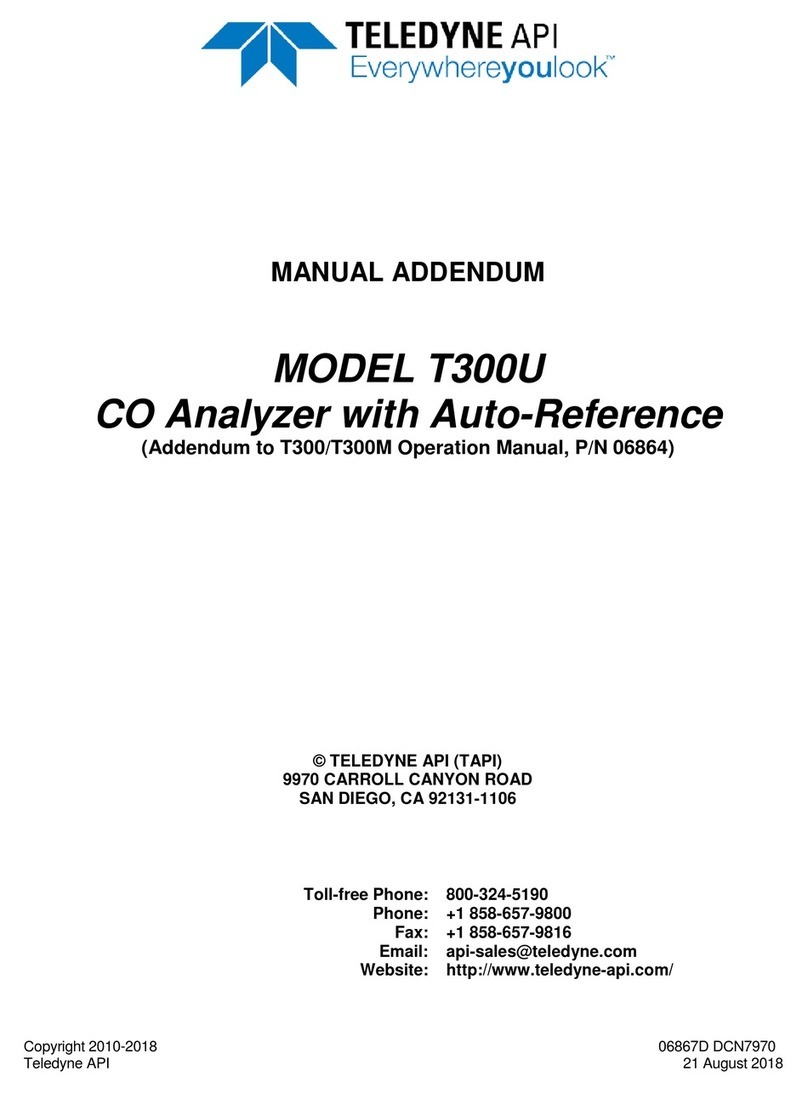
TELEDYNE API
TELEDYNE API T300 Installation and operating instructions

TELEDYNE API
TELEDYNE API T300M User manual

TELEDYNE API
TELEDYNE API T200U NOy User manual

TELEDYNE API
TELEDYNE API T300 User manual
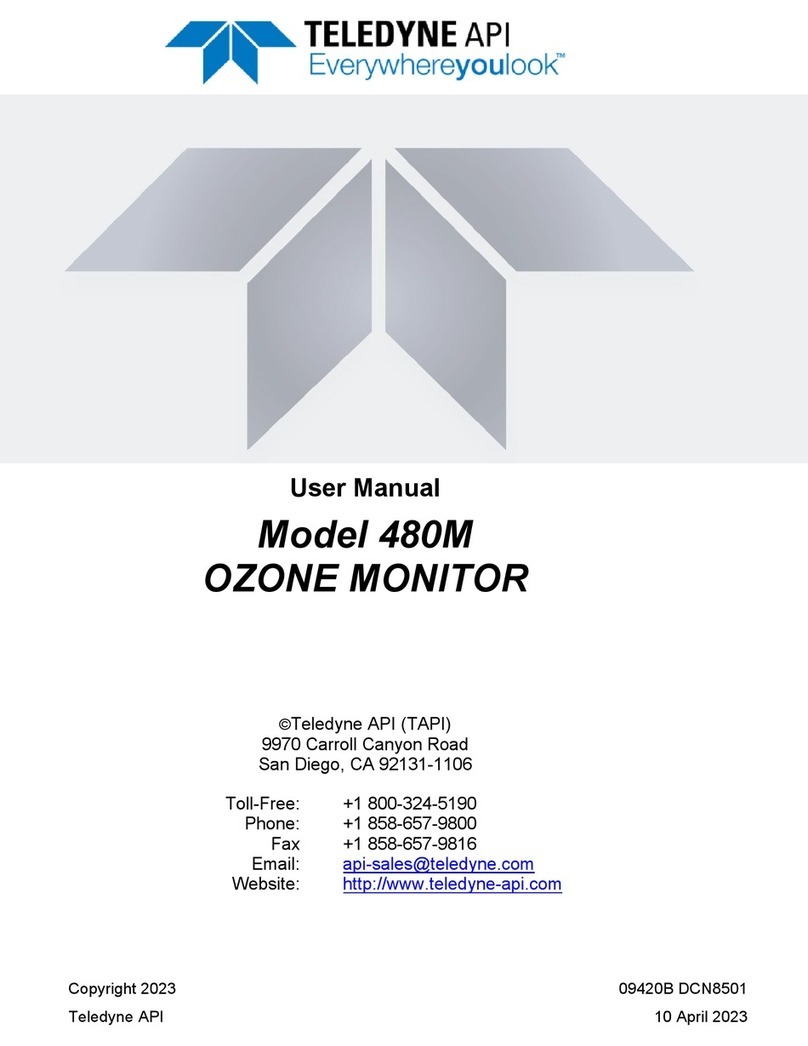
TELEDYNE API
TELEDYNE API 480M User manual
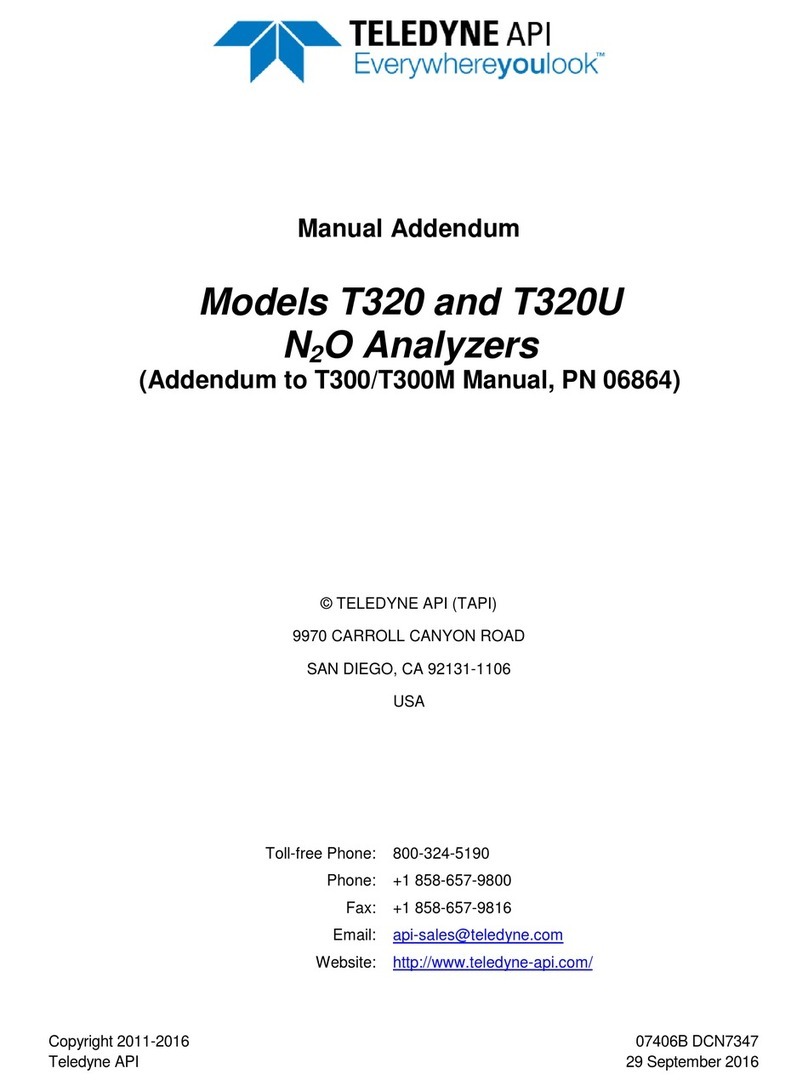
TELEDYNE API
TELEDYNE API T320U Installation and operating instructions

TELEDYNE API
TELEDYNE API T100U Installation and operating instructions
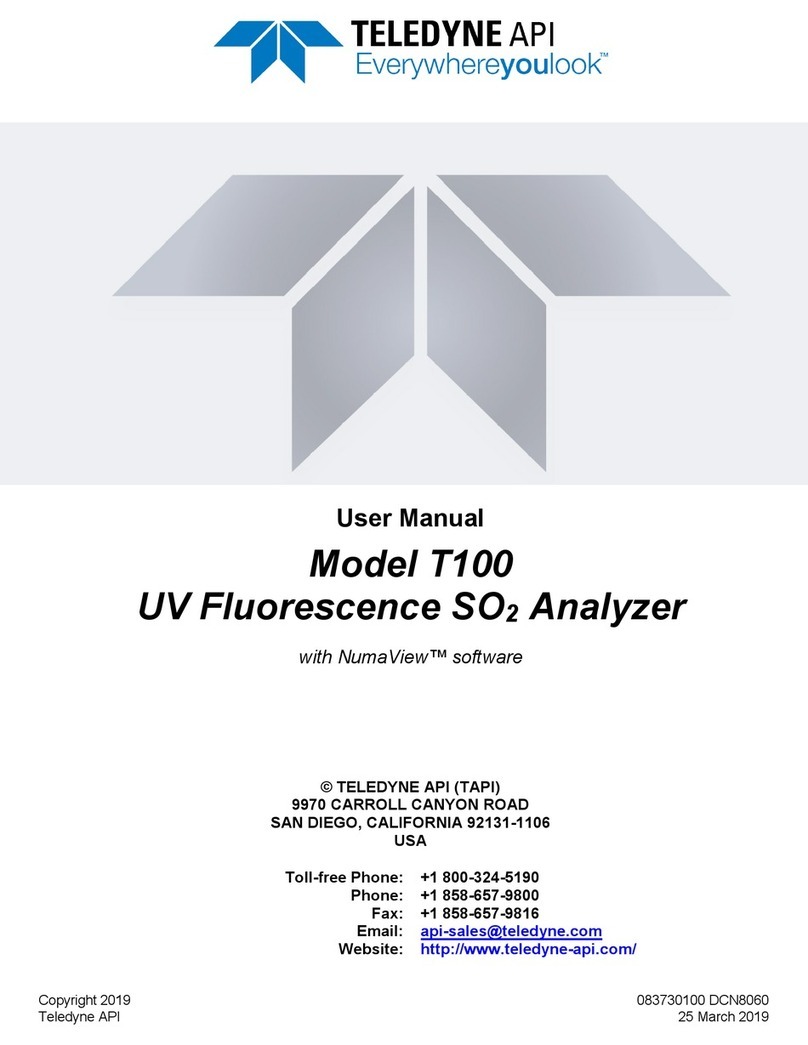
TELEDYNE API
TELEDYNE API T100 User manual
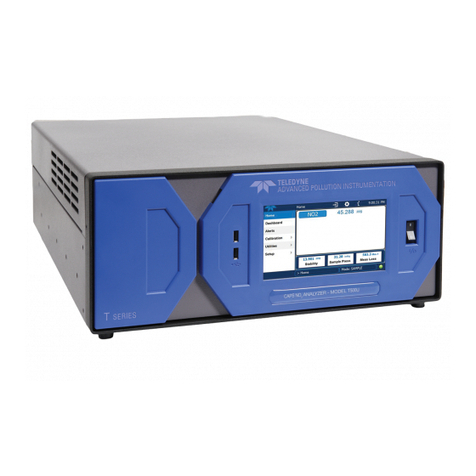
TELEDYNE API
TELEDYNE API T500U User manual

